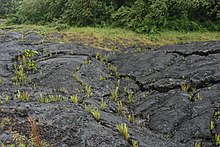Pioneer species

Pioneer species are resilient
For humans pioneer species, because they quickly occupy disrupted spaces, are sometimes treated as
Pioneer flora
Some lichens grow on rocks without soil, so may be among the first of life forms, and break down the rocks into soil for plants.[11] Since some uninhabited land may have thin, poor quality soils with few nutrients, pioneer species are often hardy plants with adaptations such as long roots, root nodes containing nitrogen-fixing bacteria, and leaves that employ transpiration. Note that they are often photosynthetic plants, as no other source of energy (such as other species) except light energy is often available in the early stages of succession, thus making it less likely for a pioneer species to be non-photosynthetic.
The plants that are often pioneer species also tend to be wind-pollinated rather than insect-pollinated, as insects are unlikely to be present in the usually barren conditions in which pioneer species grow; however, pioneer species tend to reproduce asexually altogether, as the extreme or barren conditions present make it more favourable to reproduce asexually in order to increase reproductive success rather than invest energy into sexual reproduction. Pioneer species will eventually die, create plant litter, and break down as "leaf mold" after some time, making new soil for secondary succession (see below), and releasing nutrients for small fish and aquatic plants in adjacent bodies of water.[12]
Some examples of pioneering plant species:
- Barren sand - lyme grass (Agropyron pungens), Marram grass (Ammophila breviligulata)
- Salt water - Spartina anglica).
- Clear water - mosses, freshwater eel grass (Vallisneria americana).
- Solidified lava flows (volcanic rock) -
- in Hawaii: swordfern (Polystichum munitum), ‘ōhi‘a lehua (Metrosideros polymorpha), ‘ohelo (Vaccinium reticulatum) and ‘āma‘u (Sadleria cyatheoides);[13]
- on Surtsey: lichen (Stereocaulon vesuvianum and Placopsis gelida) and moss (Racomitrium ericoides);[14] green algae
- Disturbed areas such as construction sites, road cuttings and verges, cultivated lands - see ruderal species
- Bare clay - Orchids
- Mountains - Lichens
Pioneer fauna
On land

- Bare rock
- Weathering allows hardy pioneer species to grow on the rocks.
- Decomposition of pioneer species provides organic material to make soil.
- Small annual plants are able to grow on the soil.
- As the soil layer grows plants such as trees are able to colonize the area.
The pioneering
Though vertebrates in general would not be considered pioneer species, there are exceptions. Natterjack toads are specialists in open, sparsely vegetated habitats which may be at an early seral stage.[15] Wide-ranging generalists visit early succession stage habitats, but are not obligate species of those habitats because they use a mosaic of different habitats.
Vertebrates can affect early seral stages. Herbivores may alter plant growth. Fossorial mammals could alter soil and plant community development. In a profound example, a seabird colony transfers considerable nitrogen into infertile soils, thereby altering plant growth. A keystone species may facilitate the introduction of pioneer species by creating new niches. For example, beavers may flood an area, allowing new species to immigrate.[16]
Under water
The concept of ecologic succession also applies to underwater habitats. If a space becomes newly available in a reef surrounding, haplosclerid and calcareous sponges are the first animals to initially occur in this environment in greater numbers than other species. These types of sponges grow faster and have a shorter life-span than the species which follow them in this habitat.[17]
Secondary succession and pioneer species
The term pioneer species is also used to refer to the first species, usually plants, to return to an area after disturbance as part of the process of
Pioneer species tend to be fast-growing, shade-intolerant, and tend to reproduce large numbers of offspring quickly. The seeds of pioneer species can sometimes remain viable for years or decades in the soil seed bank and often are triggered to sprout by disturbance.[19] Mycorrhizal fungi have a powerful influence on the growth of pioneer species.[20]
Some examples of the plants in such areas include:[citation needed]
- Raspberry - Rubus spp.
- Heaths - Ericaceae spp.
- native, introduced, and invasive species: such as fire dependent seed, cone, and resprouter chaparral genera.[21]
See also
References
- ISBN 9780313359637.
- ^ ISBN 978-0-444-64130-4, retrieved 2024-04-13
- ^ "Taraxacum officinale". www.fs.usda.gov. Retrieved 2024-04-13.
- PMID 36329111.
- ^ ISSN 0167-8809.
- ISSN 0378-1127.
- ISSN 0100-6762.
- ISSN 2076-3417.
- ISSN 0378-1127.
- ISBN 978-0-323-98434-8, retrieved 2024-04-13
- ^ LICHEN BIOLOGY AND THE ENVIRONMENT, LICHENS OF NORTH AMERICA, Sylvia and Stephen Sharnoff, [1]
- ISBN 9780521529549.
- ^ Amazing Lava Products and Forms, U.S. National Park Service. Retrieved 2015-06-16.
- ^ "Surtsey - Colonization of the land".
- S2CID 25656968.[permanent dead link]
- ISBN 978-0070941250.
- ^ J. Vicente, M. A. Timmers, M. K. Webb et. al (2022) Ecological succession of the sponge cryptofauna in Hawaiian reefs add new insights to detritus production by pioneering species.Scientific Reports, 20452322, 9/5/2022, Vol. 12, Iss. 1 doi:10.1038/s41598-022-18856-8
- )
- S2CID 11269697.
- S2CID 86302550.
- ISSN 1442-9993.
External links
 Media related to Pioneer plants at Wikimedia Commons
Media related to Pioneer plants at Wikimedia Commons
